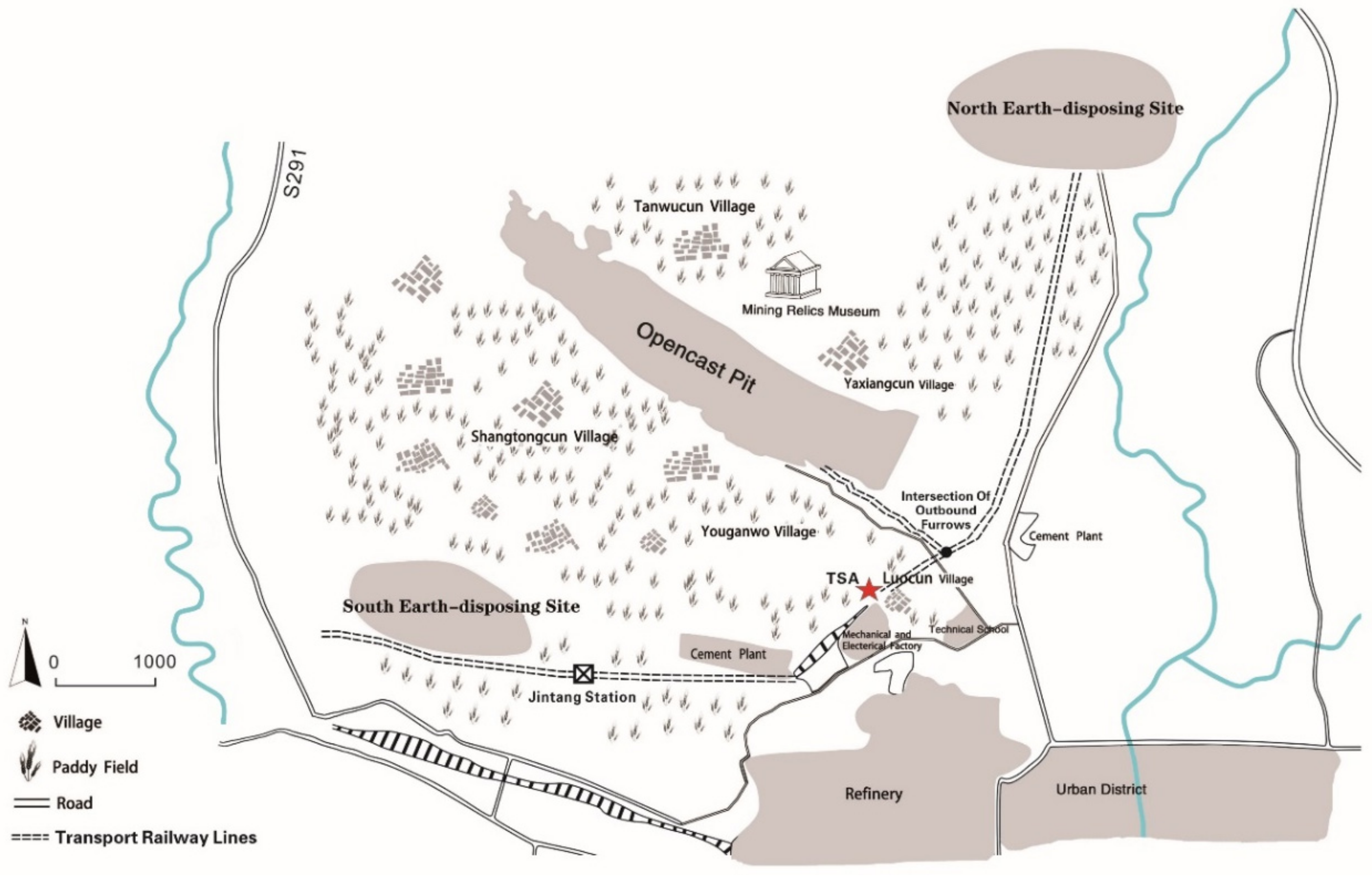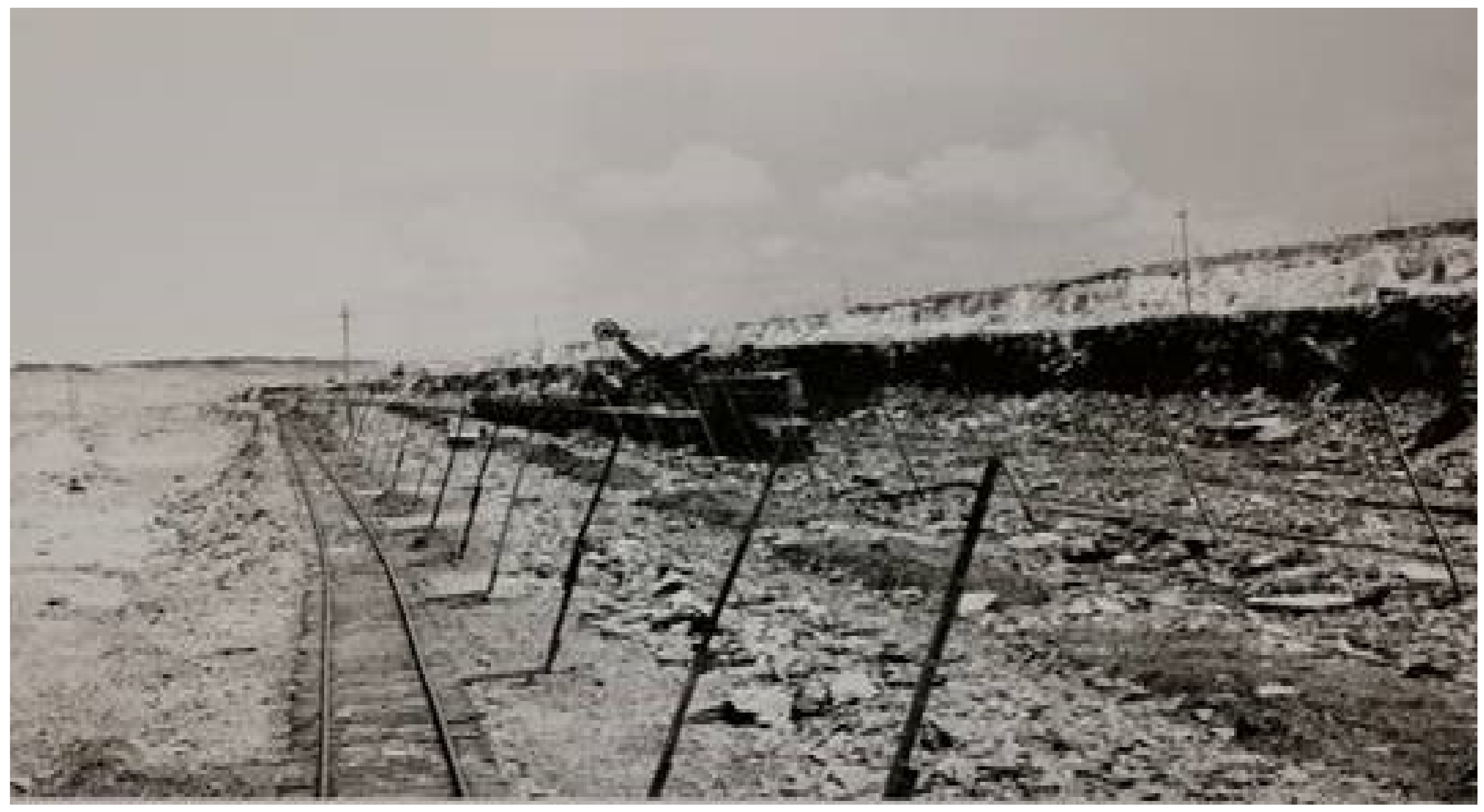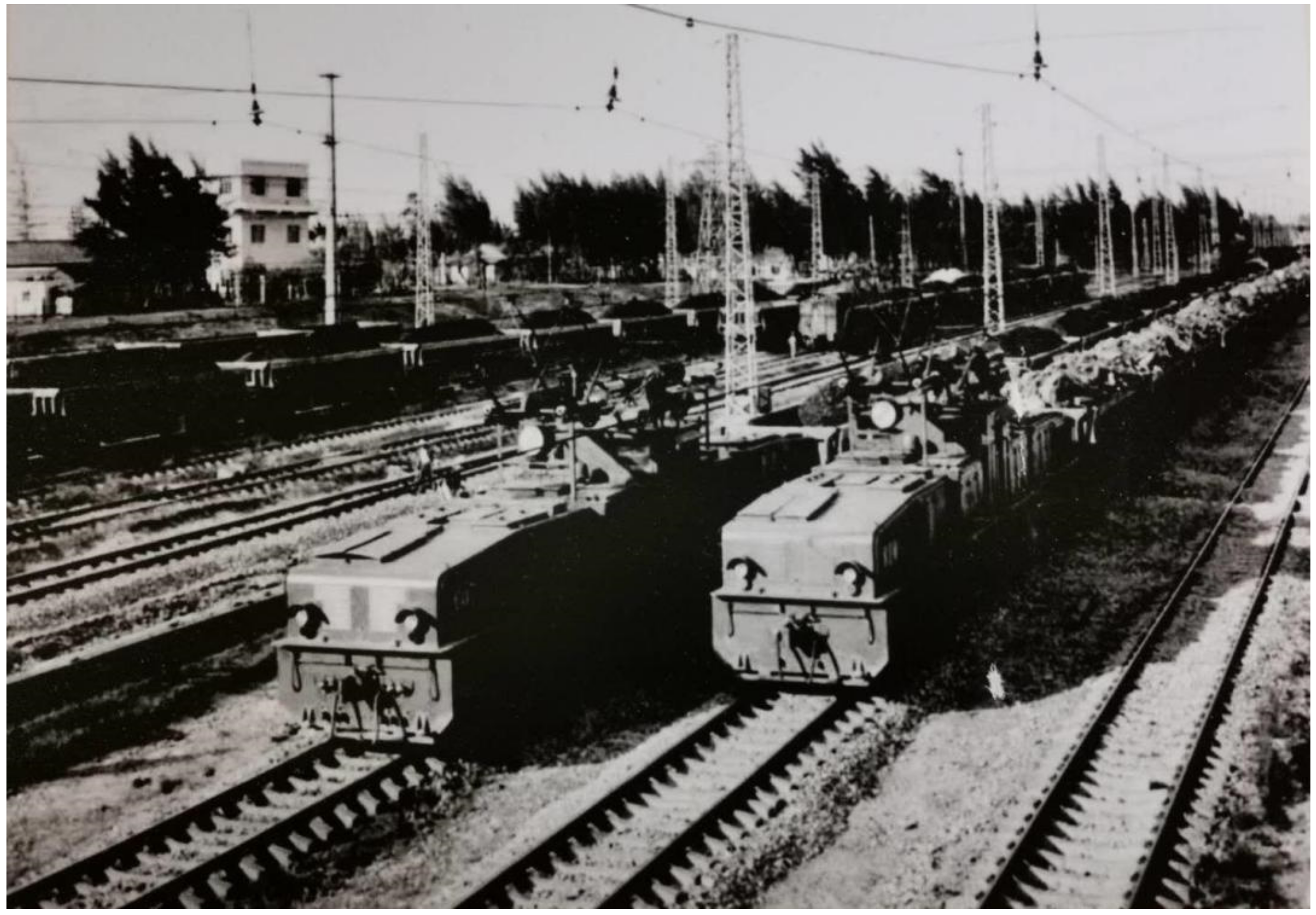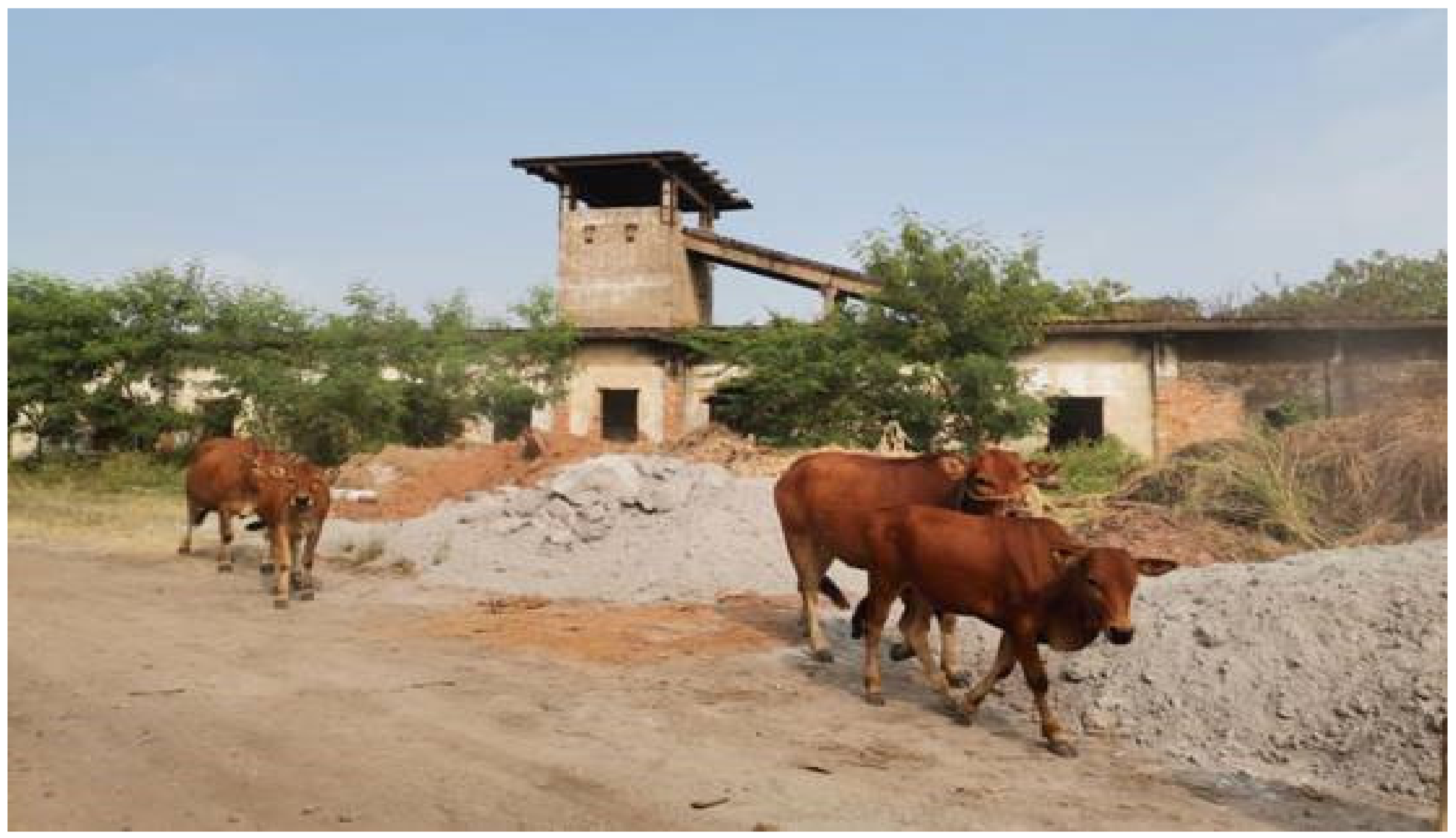Evoking the Industrial Past at the Urban-Rural Border Region: Social Movements and Cultural Production
Abstract
1. Introduction
2. Opencast Pit—The Birthplace of “Southern Oil City”
3. Theoretical Perspectives
3.1. Hybrid Geographies
3.2. Non-Representational Landscape in Memories
3.3. Taskscape
4. Methods
5. Results & Discussion
5.1. Taskscape of “On-the-Way”
At the daily pre-shift meeting, the monitor talked about safety items, braking distance before an individual red-light, the shift-hand site of every train, the influence of various construction conditions on the railway, and so on, and he handed over the shift record to the next monitor.(D2)
I held on the whole night and dared not sleep, afraid of criticism and deductions of wages while being caught; that was very troublesome. Sometimes the monitor on duty would call me up to take a walk to be keep me awake.(M1)
The monitor knows the locations of the trains on the rails through the dispatcher and assigns drivers to take over at the pre-shift meeting. Drivers get to the trains by rail bus; that’s very troublesome for unfixed sites. In case of railway maintaining or signals failing, the off-work train has to wait on the rail for 2–3 h and the drivers come back the canteen very late.(M2)
In the pit are many high ‘palms’ (mining platforms) 20 to 30 m high that I ever climbed. The shale has been drilled and shaken loose by blast. On rainy days, it’s very difficult to walk on the shale, which is soaked and more slippery. You have to watch out for some fissures in the shale stairs; otherwise, you’d have a fall.(M1)
Some villagers went into the pit to pick up some good shale and take back home. All the good shale was deep under the palm. Once it rained cats and dogs suddenly, someone without a raincoat hid under the palm for cover. The rain burst the shale down and he was hit dead.(M1)
Once, at night, while passing the Jintang station to the south earth-disposing site, I was tired and falling asleep standing. I was dreaming that the train derailed and overturned and suddenly awoke with a jolt, no longer sleepy.(D1)
The rail motor is light and fast. It must follow the signals, stopping at red and moving at green. No matter how fast you drive, the key is that you can critically stop the rail motor in time, especially on a rainy day.(M1)
Every train has one or two boiling water buckets. The drivers cook lunch themselves. There’s a platform tied up by sleepers beside the rail to the pit. The driver stops the train on the position of the platform, carrying buckets down for water. When he comes back, another driver helps take the buckets and they drive away.(M1)
Three long horns for adding water, three long followed by two short horns for adding coal. The switchman reports to the dispatcher to adjust the train route. The driver puts a ruler into the tank to plumb the depth of water and decides when to add water. While the fireman suggests whether to add coal.(D1)
5.2. Urban-Rural Intersection: Interweaving Human and Non-Human Movements
At that time, the train repair shop was the children’s paradise. It had no bounding wall and we went in and out at will, often playing hide-and-seek and stone fights nearby. At night, the flagmen took us to the pit to play, swinging the flags, changing the light’s colour to give signals.(W5)
Sometimes I went to the coal yard to pick up some wood and broken coal for back home. The men on duty at the coal yard didn’t pay much attention to me since we met often. (No barbed fence and bounding wall).(V1)
In about the 1960s, the pit embodied Luocun village as a ‘sideline team’, exclusively supplying food, vegetables to the families of the miners. My father was the production team leader at that time. Together with several other people in the village, he sent coal to the families with a wooden cart. They got along well with each other.(V1)
At that time, life was so hard that we cleared wasteland to grow vegetables on our own. My father found a plot of land used to store coal cinder over the coal yard, and he ploughed the land, spread soil on the surface and grew vegetables by water passing through the TMS drain.(V2)
In the year of 1981 or 1982, amid the reform and opening up, the country distributed farmland to households. My family needed to farm rice, but I couldn’t come home in daylight in the farming season. I had to come home at night and finished raking and ploughing the fields so that my wife could plant rice seedlings the next day, she was very hard.(W2)
In the slack seasons, some workers had small businesses in private. They came back to their villages and brought sweet potato, taro and corn from home on Saturday evening, and they cooked those and sold them in urban areas on Sunday. They together sold fruits, such as litchi, longan and jackfruit, yielded by their families. As they sold out, the workers returned back to the factory on Monday.(W1)
I live in Jinshan town and carry on trade in tea for 30 years. I often went to the strip mine to sell before. Many workers were there. I went once every two days and I did business for 20 days in a month. Initially, I rode a bike for over an hour to the mining team, dump team and traffic team, anywhere there was a way to.(B1)
I’d been to the mechanical and electrical factory, which had several job teams with more than ten fellows each. They got five to six bags of tea every time. They like Xindong tea. My tea is fresh and never mixed with aged tea. They said they had fewer colds after drinking my tea. The workers doing hard work bought some more. Those of laying railway, switching railway, checking railway were exposed to the sun and they wet their whistles by drinking tea. The office people also drunk my tea while they bought that more expensive.(B1)
People of the duty room cleaned up waste coal cinders in the coal yard and sold them at intervals. Some money was kept as the team’s expense, the extra would be given to the workers. The monitor cost 4 or 5 Yuan to buy a package of Xindong tea and invited the drivers to drink. He made a pot of tea and the room was full of the fragrance of tea.(B1)
After 1980, every team had bought their own tea set. The old master went to work early and got to the team room at ten past seven. He made tea and tasted it for a while, then had a smoke until time for roll call and the pre-shift meeting.(W2)
6. Conclusions
Author Contributions
Funding
Conflicts of Interest
References
- Sears, J.F. Sacred Places: American Tourist Attractions in the Nineteenth Century; Oxford University Press: New York, NY, USA, 1989. [Google Scholar]
- Mah, A. Industrial Ruination, Community, and Place; University of Toronto Press: Toronto, ON, Canada, 2012. [Google Scholar]
- Wheeler, R. Mining memories in a rural community: Landscape, temporality and place identity. J. Rural Stud. 2005, 36, 22–32. [Google Scholar] [CrossRef]
- Espinoza, A.; Piper, I.; Fern’andez, R. The study of memory sites through a dialogical accompaniment interactive group method: A research note. Qual. Res. 2014, 14, 712–728. [Google Scholar] [CrossRef]
- Jones, O. An ecology of emotion, memory, self and landscape. In Emotional Geographies; Davidson, J., Bondi, L., Smith, M., Eds.; Ashgate: Aldershot, UK, 2005; pp. 205–219. [Google Scholar]
- Meier, L. Encounters with haunted industrial workplaces and emotions of loss: Class-related senses of place within the memories of metalworkers. Cult. Geogr. 2012, 20, 467–483. [Google Scholar]
- Palus, M.; Shackel, P.A. They Worked Regular: Craft, Labor, and Family in the Industrial Community of Virginius Island; University of Tennessee Press: Knoxville, YN, USA, 2006. [Google Scholar]
- Samuel, R. Theatres of Memory; Verso: London, UK, 1994. [Google Scholar]
- Qviström, M. Network ruins and green structure development: An attempt to trace relational spaces of a railway ruin. Landsc. Res. 2012, 37, 257–275. [Google Scholar] [CrossRef]
- Thrift, N. Afterwords. Environ. Plan. D Soc. Space 2001, 18, 213–255. [Google Scholar] [CrossRef]
- Thrift, N.; Dewsbury, J.D. Dead geographies and how to make them live. Environ. Plan. D Soc. Space 2000, 18, 411–432. [Google Scholar] [CrossRef]
- Stenning, A. For working class geographies. Antipode 2008, 40, 9–14. [Google Scholar] [CrossRef]
- Edensor, T. Mundane hauntings: Commuting through the phantasmagoric working-class spaces of Manchester, England. Cult. Geogr. 2008, 15, 313–333. [Google Scholar] [CrossRef]
- Hill, L. Archaeologies and geographies of the post-industrial past: Landscape, memory and the spectral. Cult. Geogr. 2013, 20, 379–396. [Google Scholar] [CrossRef]
- Jones, O.; Garde-Hansen, J. Introduction. In Geography and Memory: Explorations in Identity; Jones, O., Garde-Hansen, J., Eds.; Palgrave-Macmillan: Basingstoke, UK, 2012; pp. 1–18. [Google Scholar]
- Marks, J. Gilles Deleuze: Vitalism and Multiplicity; Pluto Press: London, UK, 1998. [Google Scholar]
- Whatmore, S. Materialist returns: Practising cultural geography in and for a more-than-human world. Cult. Geogr. 2006, 13, 600–609. [Google Scholar] [CrossRef]
- Wylie, J. Landscape; Routledge: London, UK, 2007. [Google Scholar]
- Ingold, T. Rethinking the animate, re-animating thought. Ethnos 2006, 71, 9–20. [Google Scholar] [CrossRef]
- Lorimer, H. Cultural geography: The busyness of being ‘more-than-representational’. Prog. Hum. Geogr. 2005, 29, 83–94. [Google Scholar] [CrossRef]
- Wylie, J. Depths and folds: On landscape and the gazing subject. Environ. Plan. D Soc. Space 2006, 24, 519–535. [Google Scholar] [CrossRef]
- Butler, J. Bodies that Matter: On the Discursive Limits of Sex; Routledge: London, UK, 1993. [Google Scholar]
- Dewsbury, J.-D. Performativity and the event: Enacting a philosophy of difference. Environ. Plan. D Soc. Space 2000, 18, 473–496. [Google Scholar] [CrossRef]
- Mc Cormack, D. A paper with an interest in rhythm. Geoforum 2002, 33, 469–485. [Google Scholar] [CrossRef]
- Mc Cormack, D. An event of geographical ethics in spaces of affect. Trans. Inst. Br. Geogr. 2003, 28, 458–508. [Google Scholar]
- Lorimer, H. Herding memories of humans and animals. Environ. Plan. D Soc. Space 2006, 24, 497–518. [Google Scholar] [CrossRef]
- Whatmore, S. Hybrid Geographies: Natures Cultures Spaces; Sage: London, UK, 2002. [Google Scholar]
- Mels, T. Nature, home, and scenery: The official spatialities of Swedish national parks. Environ. Plan. D Soc. Space 2002, 20, 135–154. [Google Scholar] [CrossRef]
- Greenhough, B.; Roe, E. Towards a geography of bodily biotechnologies. Environ. Plan. A 2006, 38, 416–422. [Google Scholar] [CrossRef]
- Pile, S.; Harrison, P.; Thrift, N. Patterned Ground; Reaktion: London, UK, 2004. [Google Scholar]
- Thrift, N. Steps to an Ecology of Place. In Human Geography Today; Massey, D., Allen, J., Sarre, P., Eds.; Polity Press: Cambridge, UK, 1999. [Google Scholar]
- Castree, N. False antithesis? Marxism, nature and actor networks. Antipode 2002, 34, 111–146. [Google Scholar] [CrossRef]
- Whatmore, S. Hybrid Geographies: Rethinking the Human in Human Geography. In Human Geography Today; Massey, D., Allen, J., Sarre, P., Eds.; Polity Press: Cambridge, UK, 1999. [Google Scholar]
- Stoller, P. Sensuous Scholarship; University of Pennsylvania Press: Philadelphia, PA, USA, 1997. [Google Scholar]
- Rose, M.; Wylie, J. Animating landscape. Environ. Plan. D Soc. Space 2006, 24, 475–479. [Google Scholar] [CrossRef]
- Richardson-Ngwenya, P. Performing a more-than-human material imagination during fieldwork. Cult. Geogr. 2014, 21, 293–299. [Google Scholar] [CrossRef]
- Bscher, M.; Urry, J. Mobile methods and the empirical. Eur. J. Soc. Theory 2009, 12, 99–116. [Google Scholar] [CrossRef]
- Rose, M. Landscape and labyrinths. Geoforum 2002, 33, 455–467. [Google Scholar] [CrossRef]
- Massey, D. Landscape as provocation. J. Mater. Cult. 2006, 11, 33–48. [Google Scholar] [CrossRef]
- Wylie, J. An essay on ascending Glastonbury Tor. Geoforum 2002, 33, 441–454. [Google Scholar] [CrossRef]
- Wylie, J. A single day’s walking: Narrating self and landscape on the south west coast path. Trans. Inst. Br. Geogr. 2005, 30, 234–247. [Google Scholar] [CrossRef]
- Merleau-Ponty, M. The Visible and the Invisible; Northwestern University Press: Evanston, IL, USA, 1968. [Google Scholar]
- Munn, N. Excluded spaces: The figure in the Australian aboriginal landscape. Crit. Inq. 1996, 22, 446–465. [Google Scholar] [CrossRef]
- Lorimer, H. Telling small stories: Spaces of knowledge and the practice of geography. Trans. Inst. Br. Geogr. 2003, 28, 197–218. [Google Scholar] [CrossRef]
- Lorimer, H. The geographical field course as active archive. Cult. Geogr. 2003, 10, 278–308. [Google Scholar] [CrossRef]
- Ingold, T. The Perception of the Environment: Essays on Livelihood, Dwelling and Skill; Routledge: London, UK, 2000. [Google Scholar]
- Merleau-Ponty, M. Phenomenology of Perception; Routledge: London, UK, 1962. [Google Scholar]
- Thrift, N. Non-Representational Theory: Space, Politics, Affect; Routledge: London, UK, 2008. [Google Scholar]
- Ingold, T. An anthropologist looks at biology. Man 1990, 25, 208–219. [Google Scholar] [CrossRef]
- Hulme, M.; Truch, A. The Role of Interspace in Sustaining Identity. In Thumb Culture: The Meaning of Mobile Phones for Society; Glotz, P., Berscht, S., Locke, C., Eds.; Transaction Books: New Brunswick, NJ, Canada, 2005. [Google Scholar]
- Pred, A. Place as historically contingent process: Structuration and the time-geography of becoming places. Ann. Assoc. Am. Geogr. 1984, 74, 279–297. [Google Scholar] [CrossRef]
- Ingold, T.; Kurttila, T. Perceiving the environment in Finnish Lapland. Body Soc. 2000, 6, 183–196. [Google Scholar] [CrossRef]
- Nadasdy, P. The politics of TEK: Power and the integration of knowledge. Arct. Anthropol. 1999, 36, 1–18. [Google Scholar]
- Merleau-Ponty, M. Humanism and Terror; Beacon Press: Boston, MA, USA, 1969. [Google Scholar]
- Laurier, E. Doing office work on the motorway. Theory Cult. Soc. 2004, 21, 261–277. [Google Scholar] [CrossRef]
- Edensor, T. The ghosts of industrial ruins: Ordering and disordering memory in excessive space. Environ. Plan. D Soc. Space 2005, 23, 829–849. [Google Scholar] [CrossRef]
- Harvey, D. Limits to Capital, revised ed.; Verso: London, UK, 2006. [Google Scholar]
- Ingold, T. Being Alive; Routledge: London, UK, 2011. [Google Scholar]
- Williams, R. Marxism and Literature; Oxford University Press: Oxford, UK, 1977. [Google Scholar]
- Massey, D. A global sense of place. Marx. Today 1991, 6, 24–29. [Google Scholar]
- Jones, O. Geography, memory and non-representational geographies. Geogr. Compass 2011, 5, 875–885. [Google Scholar] [CrossRef]
- Yuan, H.S. Proximity, embeddedness and evolution: The role of networks in the development of the informal female labour market for glove manufacturing in Gaozhou county, China. J. Rural Stud. 2019. [Google Scholar] [CrossRef]
- Long, H.L.; Zhang, X.N. Progress in international rural geography research since the turn of the new millennium and some implications. Econ. Geogr. 2012, 32, 1–8. [Google Scholar]
- Reeves, K.; Eklund, E.; Reeves, A.; Scates, B.; Peel, V. Broken Hill: Rethinking the significance of the material culture and intangible heritage of the Australian labour movement. Int. J. Herit. Stud. 2011, 4, 301–317. [Google Scholar] [CrossRef]





| Code Name | Name Abbr. | Gender | Age | Post | Working Years | Pattern of Interview | Major Concerns |
|---|---|---|---|---|---|---|---|
| D1 | HJQ | M | 78 | Train driver | 33 | Walking interview, seated interview | Driving operation, railway signals, station configuration |
| D2 | XMS | M | 75 | Train driver | 30 | Walking interview, seated interview | Teamwork, transportation scale, departmental coordination, feeling |
| M1 | YZQ | M | 79 | Railbus driver | 33 | Seated interview | Shifting of duty, including system, detail, delay, scenery on the way |
| M2 | LZT | M | 78 | Railbus driver | 30 | Walking interview, seated interview | Daily lives of workers, interaction between workers and villagers, feeling |
| W1 | HEH | M | 80 | Train repairman at TMS | 32 | Walking interview, seated interview | Commuting between factory and home in rural, arrangement of shopwork and farm work |
| W2 | ZWX | M | 75 | Train repairman at TMS | 30 | Walking interview, seated interview | Farm products brought from home: to show identification and make friendship |
| W3 | YPS | F | 70 | Laboratory technician at TSD | 22 | Walking interview | Coordination with train drivers, working scenario of coaling and watering |
| W4 | LDM | F | 66 | Laboratory technician at TSD | 22 | Walking interview | Changes of surrounding village, witness of tea trade |
| W5 | YYW | M | 75 | Riveter | 25 | Walking interview | Dual identity of worker and villager; sense on the changes of Luocun |
| W6 | ZTF | M | 82 | Dispatcher | 31 | Walking interview, seated interview | Railway routes distribution, stations and signals arrangement, train dispatch |
| W7 | YGL | M | 64 | Blaster | 26 | Walking interview, seated interview | Oil shale production in the pit, blasting operation |
| V1 | YSR | M | 61 | Villager of Luocun | Seated interview | Difference between Luocun and surrounding villages, including employment, social welfare, pride | |
| V2 | DYH | M | 68 | Villager of Luocun | Walking interview | Identification change from villager to worker, changes of construction and livelihood of Luocun | |
| M1 | TMJ | F | 53 | Director of Luocun neighborhood committee | 30 | Seated interview | History of Luocun development with construction of the pit, management of rural-urban fringe |
| B1 | Gong | M | 66 | Tea vendor | 36 | Walking interview | Walking routes, details of selling tea to workers of the pit, taste vary from different type of workers |
© 2020 by the authors. Licensee MDPI, Basel, Switzerland. This article is an open access article distributed under the terms and conditions of the Creative Commons Attribution (CC BY) license (http://creativecommons.org/licenses/by/4.0/).
Share and Cite
Yuan, H.; Li, J.; Yin, D.; Chen, X. Evoking the Industrial Past at the Urban-Rural Border Region: Social Movements and Cultural Production. Sustainability 2020, 12, 8249. https://doi.org/10.3390/su12198249
Yuan H, Li J, Yin D, Chen X. Evoking the Industrial Past at the Urban-Rural Border Region: Social Movements and Cultural Production. Sustainability. 2020; 12(19):8249. https://doi.org/10.3390/su12198249
Chicago/Turabian StyleYuan, Huasheng, Jun Li, Duo Yin, and Xiaoliang Chen. 2020. "Evoking the Industrial Past at the Urban-Rural Border Region: Social Movements and Cultural Production" Sustainability 12, no. 19: 8249. https://doi.org/10.3390/su12198249
APA StyleYuan, H., Li, J., Yin, D., & Chen, X. (2020). Evoking the Industrial Past at the Urban-Rural Border Region: Social Movements and Cultural Production. Sustainability, 12(19), 8249. https://doi.org/10.3390/su12198249




_Li.png)

